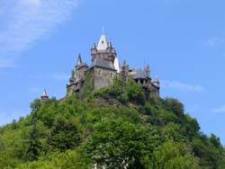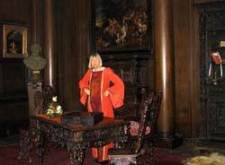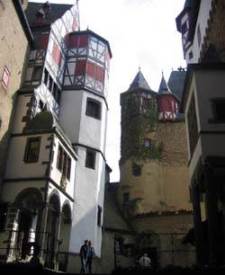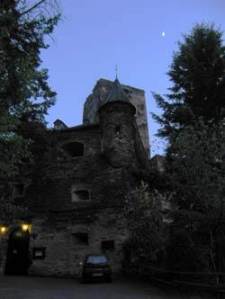|
Before leaving the timeshare to drive to the Mosel River, we stopped at the
main office to ask about the hot water in our room, which hadn't gotten
more than lukewarm the last couple of days. The maintence guy came to our room
and showed us that we had accidently
turned down the
hot water thermostat (we didn't realize what it was).
 We drove to Cochem, found a parking lot along the river, and paid at an automated
machine. Then we walked a steep path for a mile or so behind the houses of Cochem residents before reaching
the entrance to Reichsburg Castle. The earliest parts of Reichsburg castle date back to 1000 A.D.,
but in 1689 the castle was almost completely destroyed and lay in ruins until the late 19th century when it was purchased by
Mr. Louis Ravene, a rich Berlin merchant. Although Mr. Ravene reconstructed the exterior according to old plans, the interior
of the castle was reconstructed in the style of a chateau. Therefore, the interior of Reichsburg does not accurately represent
a medieval castle. In 1942, the descendants of Mr. Ravene were forced to sell the castle to the Reich. Since 1978 it has
belonged to the town of Cochem.
We drove to Cochem, found a parking lot along the river, and paid at an automated
machine. Then we walked a steep path for a mile or so behind the houses of Cochem residents before reaching
the entrance to Reichsburg Castle. The earliest parts of Reichsburg castle date back to 1000 A.D.,
but in 1689 the castle was almost completely destroyed and lay in ruins until the late 19th century when it was purchased by
Mr. Louis Ravene, a rich Berlin merchant. Although Mr. Ravene reconstructed the exterior according to old plans, the interior
of the castle was reconstructed in the style of a chateau. Therefore, the interior of Reichsburg does not accurately represent
a medieval castle. In 1942, the descendants of Mr. Ravene were forced to sell the castle to the Reich. Since 1978 it has
belonged to the town of Cochem.
 The tour guide was dressed in a period costume,
and although the tour was in German, we were given a sheet of paper with English descriptions of each room. From the little
German we understood, the paper seemed to cover the majority of what the tour guide said. Occasionally she would speak to us in English to add some
information that was not on the paper. Some of the interesting things we saw included a suit of armor made for a "giant" medieval warrior
(over 7 feet tall) and a display of tankards,
which held the amount of wine one monk was allowed to drink in a day (5 liters).
The tour guide was dressed in a period costume,
and although the tour was in German, we were given a sheet of paper with English descriptions of each room. From the little
German we understood, the paper seemed to cover the majority of what the tour guide said. Occasionally she would speak to us in English to add some
information that was not on the paper. Some of the interesting things we saw included a suit of armor made for a "giant" medieval warrior
(over 7 feet tall) and a display of tankards,
which held the amount of wine one monk was allowed to drink in a day (5 liters).
After finishing the tour we decided to eat lunch
at the castle restaurant before continuing to Burg Eltz. We had potato soup with sausage, and sausage with potato salad and vegetables.
We also had a glass of halbtrocken riesling and apfel
juice to drink.
 Burg Eltz has been the home2 of the Eltz family for almost 1000 years. It is constructed on top of a massive rock, surrounded on three
sides by the River
Eltz. The Eltz River is a tributary of the Mosel River and the castle's location allowed control of this major trade route in medieval times.
Burg Eltz is one of the few Rhenish castles never to have been destroyed. By virtue of skillful diplomacy,
the castle avoided conflict during the 30 Years War when most of the Rhein castles were destroyed by the French.
Burg Eltz has been the home2 of the Eltz family for almost 1000 years. It is constructed on top of a massive rock, surrounded on three
sides by the River
Eltz. The Eltz River is a tributary of the Mosel River and the castle's location allowed control of this major trade route in medieval times.
Burg Eltz is one of the few Rhenish castles never to have been destroyed. By virtue of skillful diplomacy,
the castle avoided conflict during the 30 Years War when most of the Rhein castles were destroyed by the French.
The Michelin Green Guide
was the only guide book for Germany that we had brought. It indicated that we should turn once we reached Hatzenport to get to Burg Eltz.
So, although we passed two signs directing us "Zum Burg Eltz", we continued on.
We eventually found our way to Burg Eltz using the directions provided by the Green Guide, but
for quite a few miles we were driving on a road so narrow that when two cars were heading in opposite directions, one would have to pull over.
We thought for sure we had missed a turn somewhere, so when we saw a woman walking her dogs, we slowed down, pointed the way we were going,
and asked "Zum Burg Eltz?". She said, "Jah" and then continued with a bunch of other words that we didn't understand, but at least we knew we were headed in the right
direction.
 After the road returned to a normal width, we drove through a city that we think may have been Kalt. We missed a turn, but eventually got headed back
in the correct direction. We saw signs along the road indicating we had arrived at Burg Eltz, and when we pulled into the parking lot we talked to a man collecting money. He didn't speak any
English, but we figured out that we needed to pay him 1.50 EUR and then park. We saw a van shuttling people down to the castle for a fee, but it was
nice out, so we decided to walk. On the way down to the castle, we passed two men walking back up who were speaking in English to each other. We
asked them how long the walk was. They told us it was less than a kilometer and would only take 15-20 minutes, but the path was steep. Although, the
steepness of the path made walking difficult, it also provided excellent views of Burg Eltz.
After the road returned to a normal width, we drove through a city that we think may have been Kalt. We missed a turn, but eventually got headed back
in the correct direction. We saw signs along the road indicating we had arrived at Burg Eltz, and when we pulled into the parking lot we talked to a man collecting money. He didn't speak any
English, but we figured out that we needed to pay him 1.50 EUR and then park. We saw a van shuttling people down to the castle for a fee, but it was
nice out, so we decided to walk. On the way down to the castle, we passed two men walking back up who were speaking in English to each other. We
asked them how long the walk was. They told us it was less than a kilometer and would only take 15-20 minutes, but the path was steep. Although, the
steepness of the path made walking difficult, it also provided excellent views of Burg Eltz.
We each paid 6 EUR for tickets to the castle tour and then headed to the courtyard, in the center of Burg Eltz, to wait for it to start. The tour was in German,
but again we were given a couple of pages with English descriptions of what we were seeing, and our tour guide spoke English well.
We were not allowed to take pictures of the interior of the castle, but the official Burg Eltz website has
pictures and descriptions of the tour. After the tour we decided to ride the shuttle back to
our car instead of walking up the steep path. The shuttle cost 1.50 EUR each, but was well worth it.
After leaving Burg Eltz, we followed the Mosel north to Koblenz and then drove south down the east bank of the Rhein until we reached Kaub.
We had arranged to spend the night at Burg Gutenfels,
which is a castle-hotel located above Kaub. It was erected about 1200 and was once one
of the most important defensive structures in the Rhein Valley. It was besieged numerous times in the Middle Ages, but always survived to
one degree or another, until the early 1800s when the woodwork, the masonry, and the contents of the castle were sold. Luckily in 1833, an
archivist acquired the ruin and rescued it from further destruction. It was later renovated and served as a rest home2 and a youth meeting place
before becoming the hotel it is now.
 We had missed a sign for the castle, but didn't realize it, so we ended up driving around Kaub for a little while. Julie had been doing most of the driving throughout
the trip, but the streets in Kaub were so steep, narrow, and crooked that Julie didn't feel comfortable with the manual transmission, so Paul
took over until we found our way to the castle. We drove up a winding road to park at the gate of Burg Gutenfels. We walked through the main gate
and followed the arrows to the courtyard where the office was located. A hotel employee was walking down the stairs in the middle of the courtyard
as we entered. We hadn't yet looked up in our German phrase book how to say that we had a reservation, so we simply said the name of our room,
"Stockheim".
The woman got someone who spoke better English to check us in, and after that we brought our luggage from the car up to our room and then drove
back down to Kaub to find somewhere to eat before everything closed.
We had missed a sign for the castle, but didn't realize it, so we ended up driving around Kaub for a little while. Julie had been doing most of the driving throughout
the trip, but the streets in Kaub were so steep, narrow, and crooked that Julie didn't feel comfortable with the manual transmission, so Paul
took over until we found our way to the castle. We drove up a winding road to park at the gate of Burg Gutenfels. We walked through the main gate
and followed the arrows to the courtyard where the office was located. A hotel employee was walking down the stairs in the middle of the courtyard
as we entered. We hadn't yet looked up in our German phrase book how to say that we had a reservation, so we simply said the name of our room,
"Stockheim".
The woman got someone who spoke better English to check us in, and after that we brought our luggage from the car up to our room and then drove
back down to Kaub to find somewhere to eat before everything closed.
We parked near the river and set out on foot to explore Kaub. The city was almost deserted; we walked for about 15-20 minutes and found only two open
restaurants. One looked like a pub of some sort and the other was 'Zum Turm',
a fancy French restaurant. We had already decided that we would try to eat at one
nice restaurant in each of the three main countries we were visiting. We figured this was a good opportunity to have our expensive meal in Germany, even
though we would be eating at a French restaurant. After examining the
menu
posted outside, we walked into Zum Turm, and told the waiter, "Eine Tisch
fur Zwei".
 We were seated at a table next to a window.
Paul had the "
Barbarie duck breast fresh smoked with fresh vegetables of the season", and Julie had the
"
Filet of pike perch roasted with sweet pepper sauce". We also each got a glass of halbtrocken
Riesling wine from the region and shared a .75 liter
bottle of water. Although this was one of the fanciest restaurants we've ever eaten at, the bill with tax was only 47.20 EUR (about $57 at the time).
There was a cute dog that we think was a havanese
in the restaurant (many restaurants in Europe allow dogs inside), and he came over at the end of our meal and let us pet him. We think he was named "Mickey" and belonged to the restaurant's owner.
We were seated at a table next to a window.
Paul had the "
Barbarie duck breast fresh smoked with fresh vegetables of the season", and Julie had the
"
Filet of pike perch roasted with sweet pepper sauce". We also each got a glass of halbtrocken
Riesling wine from the region and shared a .75 liter
bottle of water. Although this was one of the fanciest restaurants we've ever eaten at, the bill with tax was only 47.20 EUR (about $57 at the time).
There was a cute dog that we think was a havanese
in the restaurant (many restaurants in Europe allow dogs inside), and he came over at the end of our meal and let us pet him. We think he was named "Mickey" and belonged to the restaurant's owner.
After dinner we drove back to the castle. The castle grounds are not open to visitors, only guests of the hotel. Although it was getting dark,
we decided to take advantage of our residency and take a look around at night. We took out our flashlight and left the room to wander
throughout the grounds. Walking around at night, we wondered what life had been like for the thousands of people who had
lived and died here over its 800 year history. After we had explored as much of the castle as we could, we returned to our room to
get some sleep.
|

